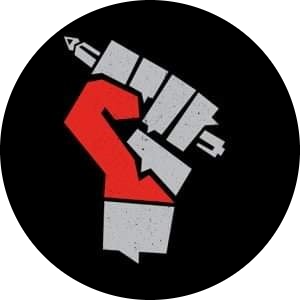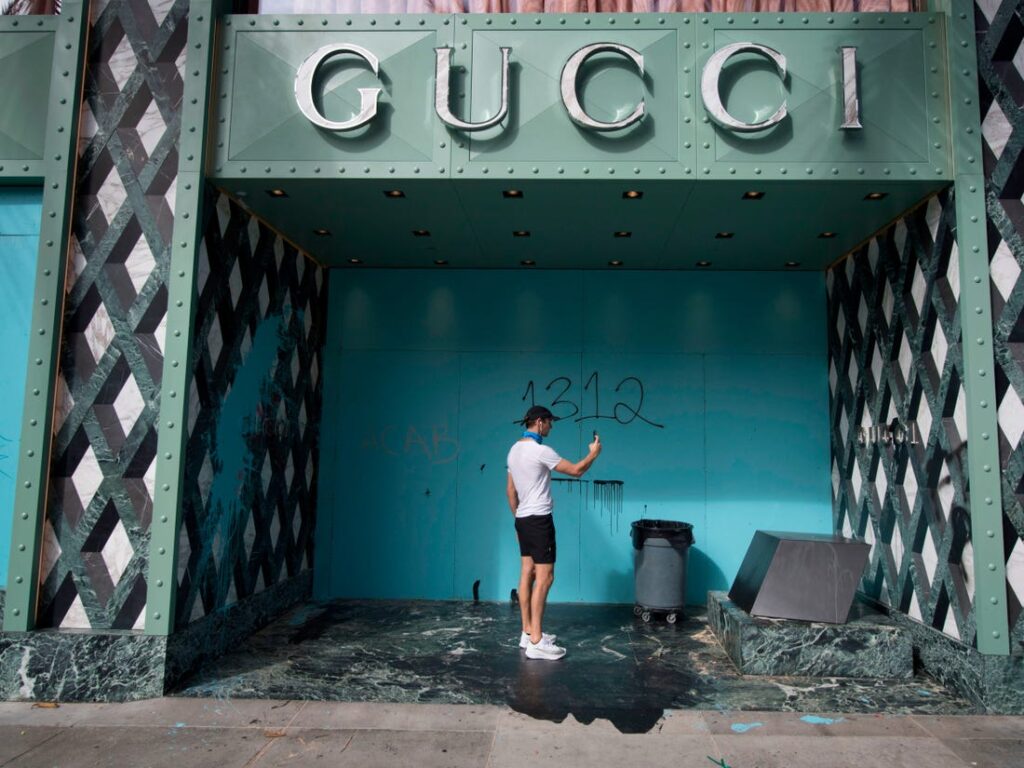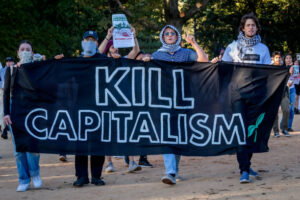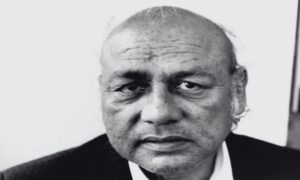Nonviolence and the civil rights movement won the battle, but lost the war, as it did not have an impact on the prejudices that existed within the system, writes Musa Syed
After weeks of violent persecution of African-Americans in the United States, the 1955 lynching of Emmett Till served as a catalyst for the civil rights movement to expose the inequalities of race within America.
In a similar fashion, 65 years later in 2020, events involving the killing of Breonna Tyler, Ahmaud Arbery, and George Floyd, have propelled the fight against racism just as strongly. All these events, mixed with COVID-19 revealing how racial inequality impacts health and earning, sparked outrage, and led to riots breaking out across the United States.
By the second day of the protests, May 27, protestors looted a Target store in Floyd’s home city of Minneapolis. The video of the event went viral, and had mixed reactions: some applauded it as being a sign of anti-capitalist sentiment, while others said it was aimless, and only hurt the movement, and society. While many grieved the conditions of African-Americans, others grieved their favourite retailers, and shopping destinations.
The phrase “merchandise can be replaced, black lives cannot” is circulating on social media amidst the chaos. At the same time, the rhetoric around protestors turning “violent” sheds negative light on the movement. This points to the question: is looting a justified form of protest?
Historically, looting has been present in agitating for rights in America. It was a part of riots in the 1960s, the 1992 LA Riots that occurred after the beating of Rodney King by the police, and even more recent riots such as the Ferguson riots in 2014. All these protests carry multiple similarities, reaching the news, but amounting to little. Time and time again, we see individuals trying to fight the racism that is entrenched within the DNA of the United States.
So, why has this become a thing?
Contrary to what the media will have you believe, property damage during protests is not done aimlessly. Firstly, it comes from a long history of the ineffectiveness of nonviolence.
Well-documented, both in mainstream, and rap music, African-Americans have been peacefully protesting for decades. Artists like Ice-T and Ice Cube have promoted opposition against police brutality, while graphically outlining the horrid consequences of coming out on the street. The civil rights movement is one of the most prominent examples of nonviolence. And with the advent of social media, blackouts, and twitter campaigns have become ways of getting the attention of society peacefully. Colin Kaepernick, in support of Black Lives Matter, decided not to stand for the Star Spangled Banner, and kneeled peacefully.
But only two things have emerged from this method: criticism, and inaction.
Despite non-violent protests throughout the 1980s, there was police brutality throughout the 2000s, and 1990s: Amadou Diallo in 1999, Sean Bell in 2006, Oscar Grant in 2009, to name a few. There were few, if any, substantive changes in police policy. African-Americans were still not given the rights they deserved. In fact, hatred increased, as evident with the rise of fascism in the United States, and the continued systematic discrimination of African-American individuals through avenues such as the police. “Walking while black” was a term coined in the 2000s that highlighted the increased racial profiling of African-Americans by law enforcement. According to a Propublica report, they made up only 29% of the population in Jacksonville, but received 55% of all pedestrian citations. The report also had accounts of African-American individuals who were threatened with arrest, or taser guns when there was no resistance on their behalf. Some even got tickets that were dismissed by judges later on.
When Black Lives Matter was formed as a way to peacefully protest, it was criticised for its name, with counter-movements, such as Blue Lives Matter, and All Lives Matter coming up. When Colin Kaepernick peacefully kneeled, he was dropped by various brands and criticised by prominent figures in the NFL, and even by President Donald Trump.
Therefore, one can argue that nonviolence and the civil rights movement won the battle, but lost the war, as it did not have an impact on the prejudices that existed within the system geared against African-Americans. These inequalities take shape even beyond the brutal police force (the lack of progress of which one can witness through the constant news of unjust racial treatment). The recent COVID-19 pandemic has exposed how African-Americans are in a system that works against them. New York City’s own data of COVID-19 deaths in April, showed that African-American New Yorkers were experiencing death rates that were at least twice those of whites, especially in more neglected areas such as the Bronx. When ranked by zip codes, 8 out of the top 10 are African-American or Latinx communities. Things have effectively gotten worse.
Furthermore, when nonviolent movements are criticised, most protesters are frustrated. Blue Lives Matter spokespeople blamed Black Lives Matter for the “collapse of social order.” The movement has a political purpose, propagating that the lives of minorities are better protected than police lives, denying the facts that show more African-Americans being killed by police officers, than police officers harmed. All Lives Matter denies the USA’s history of systematic racism against African-Americans, and refuses to acknowledge that the state does not treat every race equally. Most importantly, it presents African-Americans as aggressors carrying their own racist agenda. Activists such as Kaepernick take on peaceful protest as means of civility, but we see them losing their positionality in their respective field, and in society.
With this serving as the backdrop, it is not hard to understand why African-Americans in the United States think non-violent protest does not work. More than frustrated, they are confused: If more than a 100 years of nonviolence did not work, what will work? Hence, they turn to more direct acts, such as rioting, and looting. As Greg Tate puts it:
“Black people have developed zero tolerance for watching the state forgive killer after killer of our unarmed folk. We’ve been strangled to death by police, our children shot to death on tape by trigger-happy cops for playing with toy guns, shot in the back while running away at low-speed, shot while handcuffed and face-down on asphalt, shot in their parked vehicles visibly reaching for no weapon while their horrified wives keep filming.”
The success of these forms of protest prove their effectiveness. Gay, and transgender Americans fought police forces at the Stonewall riots, and labour riots at Haymarket did the same. By the time the Watts rebellion took place (late 1960s) the language of the unheard was recognised.
Those discouraging looting might say that the civil rights movement was nonviolent, and it was more fruitful than BLM. But, in reality, the civil rights movement was one of the most violent movements. The month before John F. Kennedy famously gave a speech on civil rights, protestors in Birmingham stood up against the police, breaking windows and throwing rocks. Robert Kennedy was afraid the riotous atmosphere would spread throughout the country, and pressurised JFK to give the speech. While it is true that this would not have been possible without the continuous nonviolent protests before this, the rioting led to the final decision being made. Reverend Martin Luther King Jr. took up an aggressive stance that most Americans forget, saying, “Freedom is never voluntarily given by the oppressor; it must be demanded by the oppressed”. By 1961, he was convinced that more aggressive tactics were necessary.
On another level, looting comes from a place of anger with racial hegemony, and its impact on the daily lives of African-Americans. Around the time of the Ferguson riots, a Twitter hashtag #suspectedlooters filled timelines with images of the past and the present. The past was represented by images of slave owners, colonisers, white cultural appropriators, and the present by large corporations being bailed out, protected by the government, and some even funding the police. Many African-Americans would say that they were not the first perpetrators of looting, but rather the first victims of it. This echoes the recent statement made by a prominent activist within BLM, Tamika Mallory, where she says that African-Americans have learnt this violence from the Americans who looted Native Americans and continue to loot African-Americans. This same racial hegemony propelled the slave trade, and black people were considered property, looting them of their rights, among other gross misconduct that happened during this time. And a part of slavery and colonialism was looting land through ideas such as the Discovery Doctrine, verified by the US Supreme Court in cases such as Johnson v. M’Intosh (1823).
When African-Americans then protest through looting, they feel as if they are taking back and turning over the power dynamic that has been imposed on them for years. It is not enough to say that America made amends, because African-Americans are still disadvantaged in terms of property. Despite a growing economy, homeownership levels for African-Americans have dropped incrementally since 2004, with it falling to 43% in 2017. While all home buyers may face issues such as student debt, the National Association of Realtors shows that this disproportionately affects African-Americans. Discrimination plays a role as well, with research showing that securing mortgages is tougher for African-Americans, and experts declaring that despite higher scores, they are still given worse financing terms than well-qualified whites. In an essay, Raven Rakia declares that property in America has always been racial, and that becomes evident with this data.
Hence it is against this capitalist system of property ownership that African-Americans rebel. But in the present, the evil is also large corporations. Looting in 2020 is not directed towards inner-city communities, unlike riots of the past, but rather towards affluent areas. In a 1968 study, Dynes and Quarantelli observe that vandalism during protests is focused on objects, and buildings with symbolic value. Protestors are focused on chain stores, and large corporations, such as Target, or specific cultural icons that people feel have not represented them. For many it may act as redistribution of property. Sociologist Andrea S. Boyles studied the 1992 LA riots, and saw that many stores that did not serve low-income communities were seen as targets, such as Whole Foods. According to her, most looters are poor, and they use this opportunity to tip the scales, not just economically, but socially as well. Some see it as a form of empowerment, giving them the ability to regain power. A similar sentiment backed up violence during the Hong Kong protests.
Victoria’s Secret, Target, Starbucks, McDonalds, Honda, Wal-Mart, AT&T, Microsoft, Nike, Sprint, Intel, IBM, Texas Instruments, Macy’s and Boeing are only a few of the major corporations that benefit from the prison-industrial complex, which helps large companies benefit from cheap labour in prisons. Many have criticised this system of corrupting notions of safety, and public service within the criminal-justice system, and replacing them with a desire for profit. Author Angela Davis calls it a pot of gold for corporations since there are no unions, no strikes, no health benefits, no unemployment insurance, etc. The prison system is known by many to be the new Jim Crow. A report by the Sentencing Project for the United Nations declares that African-Americans are more likely to be arrested, convicted, and have lengthier prison sentences compared to White Americans. Even currently, African-Americans are the second largest minority in US prisons. Hence these corporations are exploiting these individuals, especially minorities, and the corporate interests give more reason to these minorities to be kept in prison. This manifests itself in the form of prison overcrowding, leading to horrid conditions, and for-profit prisons not introducing reforms that would reduce incarcerations.
But then why are we seeing multiple videos of small businesses being looted? Here it becomes important to understand the role that the media plays when looting occurs.
It is no secret that American media itself is a tool for maintaining the status quo: it is highly partisan, void of critique on certain issues, and more respectful to white killers than black victims. The Kerner Commission, set up by Lyndon B. Johnson, after the riots in the 1960s, found that newsworkers often misread the actions of African-Americans and their behaviour was taken out of context. For example, reports stated that the unrest of 1967 represented the threat of racial violence against Whites – an assumption synonymous with longstanding fear of African-American retaliation – whereas the actual motivation was the rage caused by systematic racism. A 2011 study about the portrayal of looting after Hurricane Katrina found that Whites dominated the speaking roles, critiquing the actions of African-Americans without contextualisation. The study concluded that while the newsworkers showed sympathy for those disadvantaged by racism, they marginalised residents who rejected White middle-class norms regarding theft and crime; an African-American looting a store is one of the most racially charged images in the white imagination. They have always been depicted as robbers, and thieves, and this same image was invoked by police forces in Ferguson when they tried to justify the killing of Michael Brown by attacking his character.
And, hence, those are the only images we will be shown. In reality, Black Lives Matter has only spoken out against large corporations, and justified looting in those aspects. Footage constantly emerges on Twitter of agitators attacking local shops, and destroying property. These agitators have been reported to include white supremacists and extreme left-wing parties as well.
According to sociologist Darnell Hunt, these narratives have been used in the past to take attention away from the actual reasons of protest, and minimise the political nature and legitimacy of their actions. It is important to consider how such a situation arose where agitators (of any race) were able to exploit these protests, and work for their own interest. Instead of focusing on the looting, the media should focus on the desperation that led citizens to this point, and the ethos behind the protests.
All of this data should not be mistaken as a defence for looting. But it is important to contextualise the act in order to understand where sentiments defending it come from. It would be unfair to say that all looters are acting on these principles – some are definitely functioning on opportunity, and recklessness. However, the organised protestors and BLM have continually rested on certain principles targeted against corporations, and the system working against African-Americans. When asked on looting, essayist, novelist, and activist, James Baldwin beautifully said:
“…how would you define somebody who puts a cat where he is and takes all the money out of the ghetto where he makes it? Who is looting whom? Grabbing off the TV set? He doesn’t really want the TV set. He’s saying screw you. It’s just judgment, by the way, on the value of the TV set. He doesn’t want it. He wants to let you know he’s there. The question I’m trying to raise is a very serious question. The mass media-television and all the major news agencies-endlessly use that word “looter”. On television you always see black hands reaching in, you know. And so the American public concludes that these savages are trying to steal everything from us, And no one has seriously tried to get where the trouble is. After all, you’re accusing a captive population who has been robbed of everything of looting. I think it’s obscene.”
The quote perfectly describes how this activity is not mindless, and irrational, but political, and a result of years of frustration that has amounted to nothing.*
In the end, it is important to educate ourselves on what certain actions mean during protests. To call something apolitical is to take all meaning from it, and rip it off its power. We see the political power that looting holds, acting as a form of expression, and rebellion. It is only our hope that America realises its vices, and appreciates the diverse voices emerging from the BLM, and the tactics they employ.
If they do not, the struggle will continue.
*The full interview is more insightful, and is a must-read for anyone trying to understand the conditions African-Americans have lived under for centuries.
The Students’ Herald News Desk focuses on reporting the latest news regarding student politics and campus updates to you.
The News Desk can be reached at admin@thestudentsherald.com




